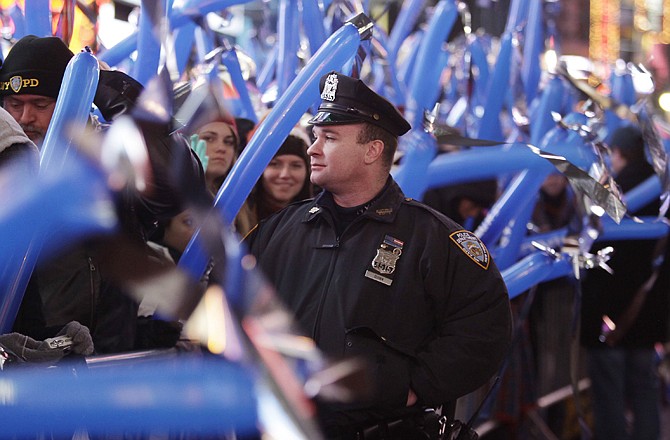NEW YORK (AP) - It's the biggest public party in the country. Nearly a million revelers will cram into the streets of Times Square to watch the ball drop on New Year's Eve.
It's also remarkably crime-free, safe and orderly. In the past decade, there have been few arrests and virtually no major problems funneling people in and out of the confetti-filled streets to ring in the New Year.
That's due mostly to what the partygoers don't notice: Throngs of police and counterterrorism officers blanketing the area, working from a security plan specifically tailored for the event.
Manhole covers are sealed. Counter-snipers are stationed on secret rooftops. Officers carry beeper-sized radiation detectors. Plainclothes officers are stationed in the pens with the crowds, along with a uniformed presence and undercover officers. Bomb-sniffing dogs are on site. Purses are searched. Checkpoints are set up and perimeters are created using concrete blocks. Passing vehicles are checked for safety. Haz-mat teams are on standby.
Police Commissioner Ray Kelly said Thursday that there are no "specific threats against the city" on New Year's Eve. The 20-inch snowstorm that left the streets far from Times Square unplowed will be a memory to the crowd. Crews have removed the large drifts and warm temperatures are helping to melt what's left.
NYPD brass tweak their security plan every year, using lessons learned from previous scares like the botched Times Square car bombing in May and the attempted bombing of a Christmas tree lighting in Portland, Ore., near Thanksgiving. NYPD counterterrorism chief James Waters mined information on the suicide bombing this month in Stockholm, Sweden.
"Intelligence informs a lot of what we do," Waters said. "Understanding the threat, always the basics, understanding what the threat is against New York, what's the threat against the country, and everything that comes behind that."
People have gathered for a century in Times Square to ring in the New Year, but it hasn't always been a family-friendly affair. In the early 1990s, before the redevelopment of the bowtie collection of streets at Broadway and Seventh Avenue, the area was overrun with crime and home to sex shops and peep shows.
Revelers would gather with plenty of liquor as shopkeepers boarded up their windows with plywood for the night, hoping no one would smash through. Dick Clark broadcast his ABC show from the area, but he did it inside, away from the crowds.
Longtime residents say it was a boozy, drunken mess.
"In the 1990s, the police wouldn't even let us play music on an outdoor sound system," said Tim Tompkins, president of the Times Square Alliance, which runs the event along with Countdown Entertainment. "They were afraid to draw any more people because it was wild."
But Disney, upscale hotels, theme stores and restaurants arrived in the mid-1990s and changed the feel of the area and drew more families and tourists, and with it, a softer crowd.
Police began to ramp up their security effort with worries over millennium threats.
Officers used metal pens to control where the crowd stood - keeping a path clear for emergency trucks. And they banned alcohol and backpacks. Uniformed police officers flooded the area. Plainclothes officers roamed the crowds.
After Sept. 11, 2001, "we added a counterterrorism overlay" to New Year's security, said Paul Browne, the NYPD's deputy commissioner for public information. "We have kept changing it based on the needs ever since."
Since the terror attack, there have been at least six foiled plots against the city - including the plot by Faisal Shahzad to bomb Times Square with a used car stuffed with a propane-and-gasoline bomb on May 1.
The department has answered with ever-developing tools, like the network of private and police cameras called the Lower and Midtown Manhattan Security initiatives. The department recently added 500 cameras to the subway stops at Times Square, Grand Central Terminal and Penn Station.
The cameras are managed at a command center in lower Manhattan, where a single high-bandwidth fiber optic network connects the cameras to police. It will be used New Year's Eve to help track any suspicious activity.
The department meets months in advance to set rules and share plans with the area restaurants and hotels that host fancy parties, along with the Times Square Alliance. They plot out where TV trucks will be stationed, and the best exit routes in case of an emergency.
Metal pens are set up to hold crowds around 3 p.m. on Dec. 31 and go back as far as Central Park depending on the crowds. Backpacks are banned. Once you leave your place, you can't return to the same spot. Garages in the area are swept for explosives.
Hotel staff are on alert for anything unusual. Guests at the 2,000-room Marriott Marquis in the heart of Times Square aren't allowed to leave the hotel or enter it after a certain time.
"If they think they are going to just walk outside at 11:30 to see the ball drop, they're wrong," said hotel marketing director Kathy Duffy.

